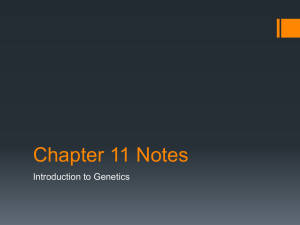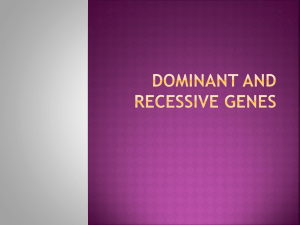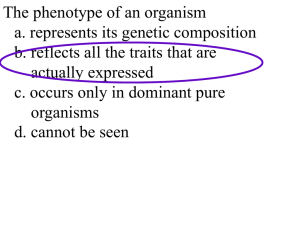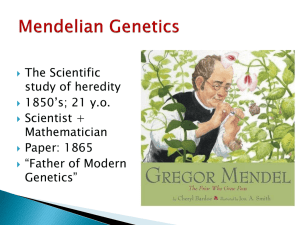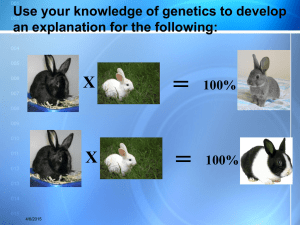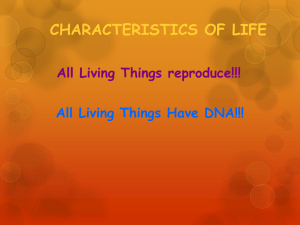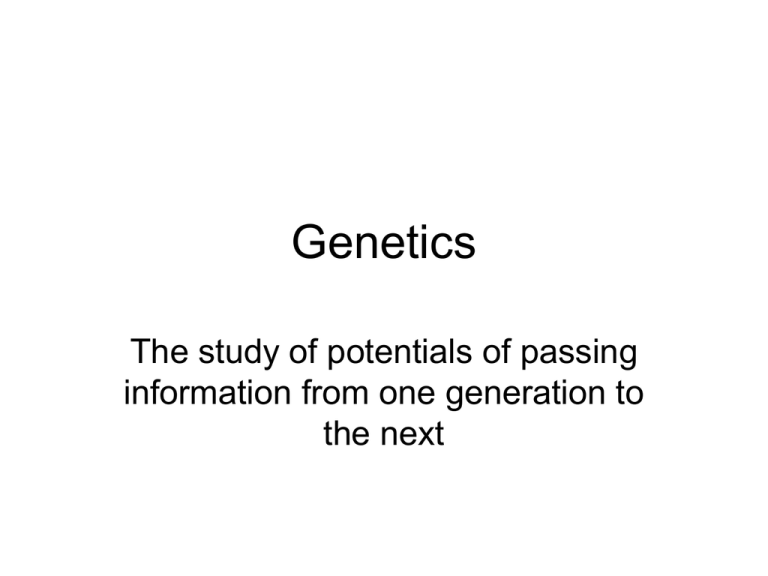
Genetics
The study of potentials of passing
information from one generation to
the next
Gregor Mendel
•
•
•
•
•
•
“Father” of genetics
Studied pea plants
Used contrasting features
Parents “bred true”
Kept good records
Studied one trait at a time
Mendel’s pea experiment
•
•
•
•
True breeding purple flower plants
True breeding white flower plants
F1 generation
F2 generation
Terminology
• Gene – unit of inheritance made of DNA
• Genes occur in pairs except in the egg
and sperm
• An allele is a different form of the same
gene
• Black hair and brown hair are alleles of the
hair color gene
Genes
• Dominant gene is one that can
overshadow another gene. Signified with
capital letter, e.g. “A”
• Recessive gene is the subordinate gene
that can be suppressed by the dominant
gene. Signified with a lower-case letter,
e.g. “a”
Genes
• Homozygous – since genes occur in pairs,
this is when both genes for the trait are the
same
• AA is homozygous dominant
• aa is homozygous recessive
Genes
• Heterozygous – genes are alleles or
different for a given trait
• Aa is heterozygous
• Carrier is sometimes used to indicate that
someone is heterozygous
Genes
• Genotype is your genetic makeup
• For example, you might be heterozygous
for hair color, Bb, one gene for black hair,
and one for blonde hair
Genes
• Phenotype is your physical appearance
• Your phenotype for hair color may be
brown
One gene problem
• Let P = Purple flower plants, or
• Let p = white flower plants, or
• The parent generation included true breeding
purple flower plants that must have been PP
(homozygous dominant) in genotype
• The parent generation included true breeding
white flower plants that must have been pp
(homozygous recessive) in genotype
Parents
• PP plant can only make a gamete with the
first “P” gene, or the second “P” gene
• (See example using E instead of P)
• pp plant can only make a gamete with its
first “p” gene, or the second “p” gene
• (See example using e instead of P)
F1 generation
• If these two parents fertilize to create
offspring, F1, or first generation, what
genotypes and phenotypes would be
possible in the F1 generation?
• Use a mathematical Punnet square to find
the probabilities
F1 generation
Gamete with
“P” gene –
parent 1
Gamete with
“P” gene –
parent 1
Gamete with “p” Offspring is
Offspring is
gene – parent 2 heterozygous – heterozygous –
“Pp”
“Pp”
Gamete with “p” Offspring is
Offspring is
gene – parent 2 heterozygous – heterozygous –
“Pp”
“Pp”
F1 generation
• 100% of the offspring would have a
genotype of Pp, or be heterozygous
• 100% of the offspring would have a
phenotype of purple flowers, since purple
is dominant over white
F2 generation
• If you take two plants from the F1
generation (Pp) and cross them, what
would be the genotypic and phenotypic
ratios of the next, or F2 generation?
F2 generation
Gamete with
“P” gene –
parent 1
Gamete with
“P” gene –
parent 2
Offspring is
homozygous
dominant –
“PP”
Gamete with “p” Offspring is
gene – parent 2 heterozygous –
“Pp”
Gamete with “p”
gene – parent 1
Offspring is
heterozygous –
“Pp”
Offspring is
homozygous
recessive – “pp”
F2 generation
• Note that the four squares in the Punnet
square do not represent four different
offspring, but rather the statistical chances
that any ONE offspring has a given trait
• Genotypic ratios are 1 homozygous
dominant : 2 heterozygous : 1
homozygous recessive
• Phenotypic ratios are 3 purple : 1 white
Try this problem
• E = unattached earlobes
• e = attached earlobes
• Problem one: Both parents have
unattached earlobes. However, they had
a son with attached earlobes. What are
the chances that their next child will have
unattached earlobes?
Try this problem
• E = unattached earlobes
• e = attached earlobes
• Problem two: One parent has unattached
earlobes and the other has attached earlobes.
They had a daughter with attached earlobes.
What are the genotypes of the parents? What
are the chances that their next child will have
unattached earlobes?
Autosomal Dominant
• The trait or disease is the result of a
dominant gene
Autosomal Recessive
• The trait or disease is the result of a
recessive gene (e.g. cystic fibrosis)
Incomplete dominance
• The dominant gene is not strong enough
to completely overshadow the recessive
gene
• Example: If a red flower plant (dominant)
crosses with a white flower plant
(recessive) and the offspring have pink
flowers (heterozygous).
Codominance
• No clear dominant or recessive gene
• Genes are equal, or codominant
• If genes for blood type A and blood type B
are codominant and you have one gene of
each, your blood type is AB
Blood typing practice
• Genes for blood types A and B are dominant
over type O
• Genes for blood types A and B are codominant
with each other
• If mom has blood type A and dad has blood type
B, and they have a son with blood type O, what
are the genotypes of these 3 people? What are
the statistical chances that their next child has
blood type AB?
Sex-Linked traits
• The sex of the person has not mattered up
until this point working on the genetics
problems. Now it does.
• These sex-linked problems are such that
the gene for the particular trait is located
on the X chromosome only.
• Recall that males are XY and females are
XX.
Colorblindness is sex linked
•
•
•
•
Colorblind is a recessive trait
Carried on the X chromosome only
Let B = normal vision and b = color blind
Mom and dad both have normal vision.
However, their second child was a
colorblind son. What are the genotypes of
the parents and what are the chances that
their next son/daughter is colorblind?




